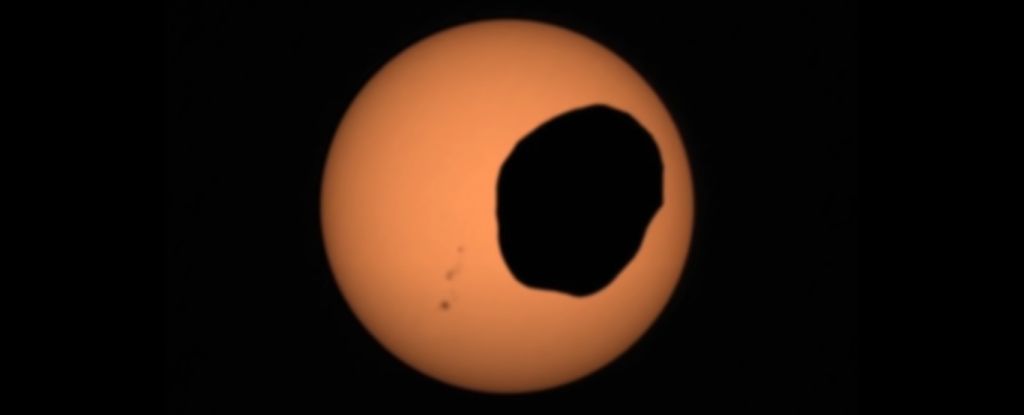Every now and again, a reminder comes along that our planet really is unusual in so many fabulous ways. Those reminders don’t even have to come from far away – they can be as close as our next-door neighbor.
Similar to Earth, Mars experiences moments where its moons cast shadows on its surface. But “eclipses” on Mars, captured by NASA rovers Opportunity, Curiosity (embedded below), and now Perseverance, are very different from those on Earth.
frameborder=”0″ allow=”accelerometer; autoplay; clipboard-write; encrypted-media; gyroscope; picture-in-picture; web-share” allowfullscreen>
Mars’ moons Phobos (“fear” in Ancient Greek) and Deimos (“dread”) circle Mars every 7.65 and 30.35 hours respectively, a relative blink compared to the 27-day orbit of Earth’s moon.
They’re also a lot smaller than the Moon, and considerably more lumpy – little moontatoes, rather than the nice round disk we see shining so argently in our night sky.
Technically, these events aren’t eclipses as we would experience them, but transits that never entirely block out the Sun’s light. When Mars’ lumpy moonlets pass between the Sun and observers on the Martian surface, they don’t cover the star as completely as the Moon can from here on Earth.
Check out an example of a transit as seen by Perseverance in the video below.
frameborder=”0″ allow=”accelerometer; autoplay; clipboard-write; encrypted-media; gyroscope; picture-in-picture; web-share” allowfullscreen>
It’s not hard to picture the Sun as a giant eyeball with a peculiar pupil, tracking something unseen to the surface-bound observer.
Fanciful notions aside, scientists have observed a strange effect on the planet with the passing of Phobos’ shadow. The Mars InSight lander, an observatory designed to measure seismic activity, tilts just slightly during these events. Scientists have attributed that slight incline to the deformation of the surface of Mars as a result of the very slight cooling effect from the reduced solar radiation.
Of the two moons, Phobos has the larger silhouette, blocking out as much as 40 percent of the light from the Sun, even when fully swallowed by the glare. Deimos, much farther and smaller, blots out much less light, highlighting just how incredibly special our planet is.
During a total solar eclipse on Earth, the disk of the Moon covers the disk of the Sun, perfectly, even though the Moon is much smaller.
This is because of a very fascinating coincidence. The Moon is about 400 times smaller than the Sun. It’s also about 400 times closer to Earth than the Sun. This means that the Sun and the Moon appear to be more or less the same size in our sky.
This does vary a bit, because neither Earth’s orbit around the Sun nor the Moon’s orbit around Earth are perfectly circular. So their sizes can appear slightly bigger or smaller, depending on orbital positions. That’s how we get annular eclipses, when the Moon doesn’t quite entirely cover the Sun, leaving a ring of light around the Moon’s disk.
Even more interestingly, the emergence of our species seems to have occurred just in time to marvel at such perfect eclipses. The Moon started its life much closer to Earth, and is currently moving away at a rate of about 3.82 centimeters (1.5 inches) a year. Give it another 600 million years or so, and total solar eclipses will no longer be possible.
The video below shows Curiosity data of a Deimos “eclipse”.
frameborder=”0″ allow=”accelerometer; autoplay; clipboard-write; encrypted-media; gyroscope; picture-in-picture; web-share” allowfullscreen>
Observing solar eclipses from Earth can teach us cool things about the Sun (and allowed a critical test of general relativity over 100 years ago).
On Mars, scientists can also use eclipses to learn things. They can link the motion of Phobos to its gravitational effect on Mars, and use that information to understand the mysterious Martian interior.
Not to mention predict the eventual fate of Phobos. The moon is inching closer and closer to Mars, and will one day grow so near that Mars’ gravity will pull it apart. Then, scientists think, the red planet will temporarily have a ring of Phobos guts.
Tracking Phobos and Deimos across the Martian sky can give more data that will help map and predict this violent fate.
A version of this article was first published in August 2022.





